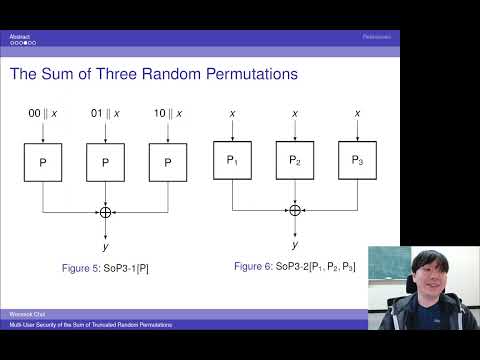CryptoDB
Multi-User Security of the Sum of Truncated Random Permutations
| Authors: |
|
|---|---|
| Download: | |
| Presentation: | Slides |
| Conference: | ASIACRYPT 2022 |
| Abstract: | For several decades, constructing pseudorandom functions from pseudorandom permutations, so-called Luby-Rackoff backward construction, has been a popular cryptographic problem. Two methods are well-known and comprehensively studied for this problem: summing two random permutations and truncating partial bits of the output from a random permutation. In this paper, by combining both summation and truncation, we propose new Luby-Rackoff backward constructions, dubbed SaT1 and SaT2, respectively. SaT2 is obtained by partially truncating output bits from the sum of two independent random permutations, and SaT1 is its single permutation-based variant using domain separation. The distinguishing advantage against SaT1 and SaT2 is upper bounded by O(\sqrt{\mu q_max}/2^{n-0.5m}) and O({\sqrt{\mu}q_max^1.5}/2^{2n-0.5m}), respectively, in the multi-user setting, where n is the size of the underlying permutation, m is the output size of the construction, \mu is the number of users, and q_max is the maximum number of queries per user. We also prove the distinguishing advantage against a variant of XORP[3]~(studied by Bhattacharya and Nandi at Asiacrypt 2021) using independent permutations, dubbed SoP3-2, is upper bounded by O(\sqrt{\mu} q_max^2}/2^{2.5n})$. In the multi-user setting with \mu = O(2^{n-m}), a truncated random permutation provides only the birthday bound security, while SaT1 and SaT2 are fully secure, i.e., allowing O(2^n) queries for each user. It is the same security level as XORP[3] using three permutation calls, while SaT1 and SaT2 need only two permutation calls. |
Video from ASIACRYPT 2022
BibTeX
@inproceedings{asiacrypt-2022-32454,
title={Multi-User Security of the Sum of Truncated Random Permutations},
publisher={Springer-Verlag},
author={Wonseok Choi and Hwigyeom Kim and Jooyoung Lee and Yeongmin Lee},
year=2022
}

